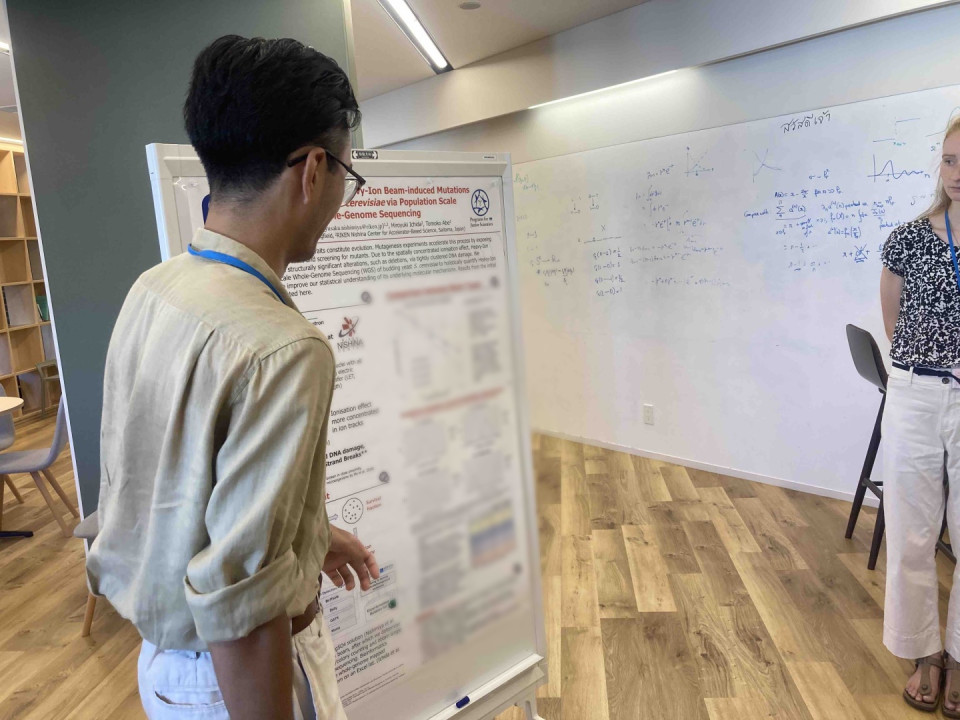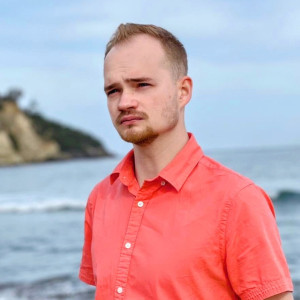Volume 267
Back to Newsletter List
Seminar Report
Lab-Theory Standing Talk #2 by Yusaku Nishimiya on September 5, 2023
2023-09-05
At this Lab-Theory Standing Talks, taken place at the third floor open space, Yusaku Nishimiya explained the effect of heavy-ion beam on yeast.
Reported by Tsukasa Tada
Lab-Theory Standing Talk #2
September 5 (Tue) 13:00 - 13:50, 2023
Upcoming Events
Seminar
iTHEMS Biology Seminar
Parameter Fitting for Glucose Homeostasis - Searching for Methods to Predict and Diagnose
September 12 (Tue) 16:00 - 17:00, 2023
Gabriel Gress (Specially Appointed Research Fellow, Mathematical Science Group, Advanced Institute for Materials Research (AIMR), Tohoku University)
The human body regulates glucose through a complex web of biological interactions, for which state-of-the-art models require dozens of variables and parameters to even emulate. But while we've had devices to measure glucose levels as far back as the 1980's, nearly all of the remaining variables and parameters cannot be measured directly to this day. While continuous glucose monitors have greatly improved the health of diabetic patients, there are still many barriers in the diagnosis of at-risk patients as well as accurately dispersing insulin to counteract future trends in glucose levels. While glucose readings are only a small window into one of many factors of how the human body maintains glucose homeostasis, we search for ways to leverage the high-frequency and high-volume data to improve the state of diagnosis and prediction in diabetic patients.
Venue: Hybrid Format (3F #359 and Zoom), Main Research Building, RIKEN Wako Campus
Event Official Language: English
Seminar
iTHEMS Math Seminar
Quasi-BPS categories
September 13 (Wed) 10:00 - 11:30, 2023
Yukinobu Toda (Professor, Kavli Institute for the Physics and Mathematics of the Universe (Kavli IPMU), The University of Tokyo)
In this talk, I will explain the notion of "Quasi-BPS category". This is the (yet to be defined) category which categorifies BPS invariants on Calabi-Yau 3-folds, and plays an important role in categorical wall-crossing in Donaldson-Thomas theory. I will explain the motivation of quasi-BPS categories, give definition in the case of symmetric quivers with potential (a local model of CY 3-folds), and their properties. If time permits, I will explain quasi-BPS categories for local K3 surfaces and their relation to derived categories of hyperkahler manifolds. This is a joint work in progress with Tudor Padurariu.
Venue: Seminar Room #359, 3F Main Research Building, RIKEN
Event Official Language: English
Seminar
iTHEMS Math Seminar
Classification of Meromorphic Spin 2-dimensional Conformal Field Theories of Central Charge 24
September 19 (Tue) 15:00 - 16:30, 2023
Möller Sven (Group Leader, Department of Mathematics, University of Hamburg, Germany)
We classify the self-dual (or holomorphic) vertex operator superalgebras (SVOAs) of central charge 24, or in physics parlance the purely left-moving, spin 2-dimensional conformal field theories with just one primary field.
There are exactly 969 such SVOAs under suitable regularity assumptions and the assumption that the shorter moonshine module VB^# is the unique self-dual SVOA of central charge 23.5 whose weight-1/2 and weight-1 spaces vanish. Additionally, there might be self-dual SVOAs arising as "fake copies" of VB^# tensored with a free fermion F.
We construct and classify the self-dual SVOAs by determining the 2-neighbourhood graph of the self-dual (purely bosonic) VOAs of central charge 24 and also by realising them as simple-current extensions of a dual pair containing a certain maximal lattice VOA. We show that all SVOAs besides VB^# x F and potential fake copies thereof stem from elements of the Conway group Co_0, the automorphism group of the Leech lattice.
By splitting off free fermions F, if possible, we obtain the classification for all central charges less than or equal to 24.
This is based on joint work with Gerald Höhn (arXiv:2303.17190)
Venue: Seminar Room #359, 3F Main Research Building, RIKEN
Event Official Language: English
Seminar
Spider silk big data drives the creation of targeted biopolymers -from polymerization to biodegradation-
September 20 (Wed) 13:30 - 15:00, 2023
Keiji Numata (Professor, Graduate School of Engineering, Kyoto University)
Our Material DX research project (http://pixy.polym.kyoto-u.ac.jp/ku_numata/index.html) is dedicated to addressing challenges in the design and synthesis of polymeric materials. Our primary objective is to establish a comprehensive material research and technical platform built upon a polymer database. Our efforts center on the creation and advancement of bioadaptive materials featuring biological functionalities and physical properties.1,2 Within the domain of polymer science, the integration of material informatics (MI) for establishing correlations between material structure and properties, along with the utilization of extensive databases, has not witnessed substantial advancement in recent times.
Structural protein such as spider silk is an eco- and bio-friendly polymer as well as one of the key factors to realize the unique properties and functions of natural tissues and organisms.3,4 However, use of structural proteins as structural materials in human life is still challenging. Spider silks are among the toughest known materials and thus provide models for renewable, biodegradable and sustainable biopolymers. However, the entirety of their diversity still remains elusive, and silks that exceed the performance limits of industrial fibers are constantly being discovered. We obtained transcriptome assemblies from 1,098 species of spiders to comprehensively catalog silk gene sequences and measured the mechanical, thermal, structural, and hydration properties of the dragline silks of 446 species.5 The combination of these silk protein genotype-phenotype data revealed essential contributions of multicomponent structures in high-performance dragline silks as well as numerous amino acid motifs contributing to each of the measured properties. We hope that our global sampling, comprehensive testing, integrated analysis and open data will provide a solid starting point for future biomaterial designs.
References
- Keiji Numata, Biopolymer Science for Proteins and Peptides, Elsevier (2021)
- Ali D. Malay, Hamish C. Craig, Jianming Chen, Nur Alia Oktaviani, and Keiji Numata, Complexity of Spider Dragline Silk, Biomacromolecules 23, 5, 1827–1840 (2022), doi: 10.1021/acs.biomac.1c01682
- Ali D Malay, Takehiro Suzuki, Takuya Katashima, Nobuaki Kono, Kazuharu Arakawa, Keiji Numata, Spider silk self-assembly via modular liquid-liquid phase separation and nanofibrillation, Science Advances, 6, 45, eabb6030 (2020), doi: 10.1126/sciadv.abb6030
- Nur Alia Oktaviani, Akimasa Matsugami, Ali D. Malay, Fumiaki Hayashi, David L. Kaplan & Keiji Numata, Conformation and dynamics of soluble repetitive domain elucidates the initial β-sheet formation of spider silk, Nature Communications 9, 2121 (2018), doi: 10.1038/s41467-018-04570-5
- Kazuharu Arakawa et al., 1000 spider silkomes: Linking sequences to silk physical properties, Science Advances 8 (41) eabo6043 (2022), doi: 10.1126/sciadv.abo6043
Venue: Seminar Room #359, 3F Main Research Building, RIKEN / via Zoom
Event Official Language: English
Seminar
iTHEMS Theoretical Physics Seminar
Induced gravitational waves from inflaton oscillons
September 22 (Fri) 14:00 - 15:30, 2023
Kaloian Dimitrov Lozanov (Project Researcher, Kavli Institute for the Physics and Mathematics of the Universe (Kavli IPMU), The University of Tokyo)
We present a new way to study cosmic inflation with gravitational waves. The gravitational signal is generated thanks to nonlinear structures in the inflaton field, called oscillons. This novel probe allows us to test models of inflation which are challenging to test with CMB experiments.
Venue: Hybrid Format (3F #359 and Zoom), Main Research Building, RIKEN Wako Campus
Event Official Language: English
Seminar
ABBL-iTHEMS Joint Astro Seminar
Progenitors and Explosion Properties of Supernova Remnants Hosting Central Compact Objects
October 6 (Fri) 10:00 - 11:30, 2023
Chelsea Braun (Ph.D. Student, Department of Physics and Astronomy, University of Manitoba, Canada)
Presented is a systematic, global study of Galactic supernova remnants (SNRs) hosting Central Compact Objects (CCOs) aimed at addressing their explosion properties and supernova progenitors. With the Chandra and XMM-Newton telescopes, a spatially resolved X-ray spectroscopy study is performed on seven SNRs that show evidence of shock-heated ejecta. Using an algorithm, we segmented each SNR in the sample into regions of similar surface brightness. These regions were fit with one- or two-component plasma shock model(s) in order to separate the forward-shocked interstellar medium from the reverse shock-heated ejecta which peak in the X-ray bands for elements including O, Ne, Mg, Si, S, Ar, Ca, and Fe. We subsequently derived the explosion properties for each SNR in the sample and found overall low explosion energies (<10^51 erg). To address their progenitor mass, we compare the measured abundances from our spectroscopic modelling to five of the most widely used explosion models and a relatively new electron-capture supernova model. Additionally, we explore degeneracy in the explosion energy and its effects on the progenitor mass estimates. However, no explosion models match all of the measured ejecta abundances for any of the SNRs in our sample. Therefore, we present our best progenitor mass estimates and find overall low progenitor masses (<=25 solar masses) and we highlight the discrepancies between the observed data and the theoretical explosion models.
Venue: via Zoom
Event Official Language: English
Seminar
ABBL-iTHEMS Joint Astro Seminar
Early Formation of Dark Matter Halos
November 24 (Fri) 14:00 - 15:15, 2023
Derek Beattie Inman (Research Scientist, RIKEN Interdisciplinary Theoretical and Mathematical Sciences Program (iTHEMS))
Cosmological observations have led to an extremely precise understanding of the large-scale structure of the Universe. A common assumption is to extrapolate large-scale properties to smaller scales; however, whether this is correct or not is unknown and many well-motivated early Universe scenarios predict substantially different structure formation histories. In this seminar I will discuss two scenarios where nonlinear structures form much earlier than is typically assumed. In the first case, the initial fluctuations are enhanced on small scales leading to either primordial black holes clusters or WIMP minihalos right after matter-radiation equality. In the second, I will show that an additional attractive dark force leads to structure formation even in the radiation dominated Universe. I will furthermore discuss possible observations of such early structure formation including changes to the cosmic microwave background, dark matter annihilation, and when the first galaxies form.
Venue: Seminar Room #359, 3F Main Research Building, RIKEN / via Zoom
Event Official Language: English
Paper of the Week
Week 2, September 2023
2023-09-07
Title: Efficient Simulation of Low Temperature Physics in One-Dimensional Gapless Systems
Author: Yuya Kusuki, Kotaro Tamaoka, Zixia Wei, Yasushi Yoneta
arXiv: http://arxiv.org/abs/2309.02519v1
Title: Involutions and the Chern-Simons filtration in instanton Floer homology
Author: Antonio Alfieri, Irving Dai, Abhishek Mallick, Masaki Taniguchi
arXiv: http://arxiv.org/abs/2309.02309v1
Title: A Semi-classical Spacetime Region with Maximum Entropy
Author: Yuki Yokokura
arXiv: http://arxiv.org/abs/2309.00602v1
If you would like to cancel your subscription or change your email address,
please let us know via our contact form.
Copyright © iTHEMS, RIKEN. All rights reserved.





